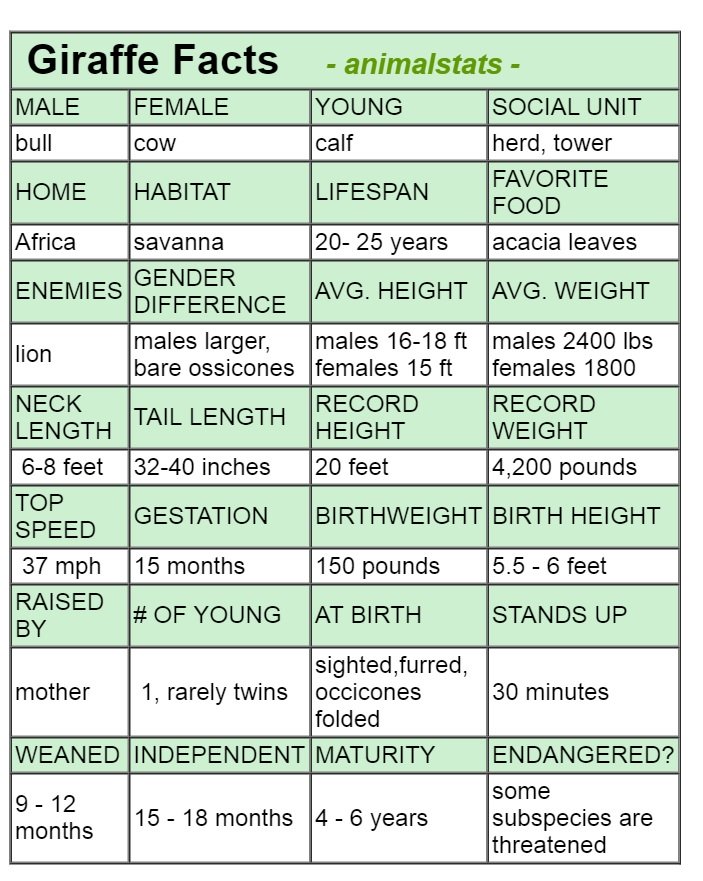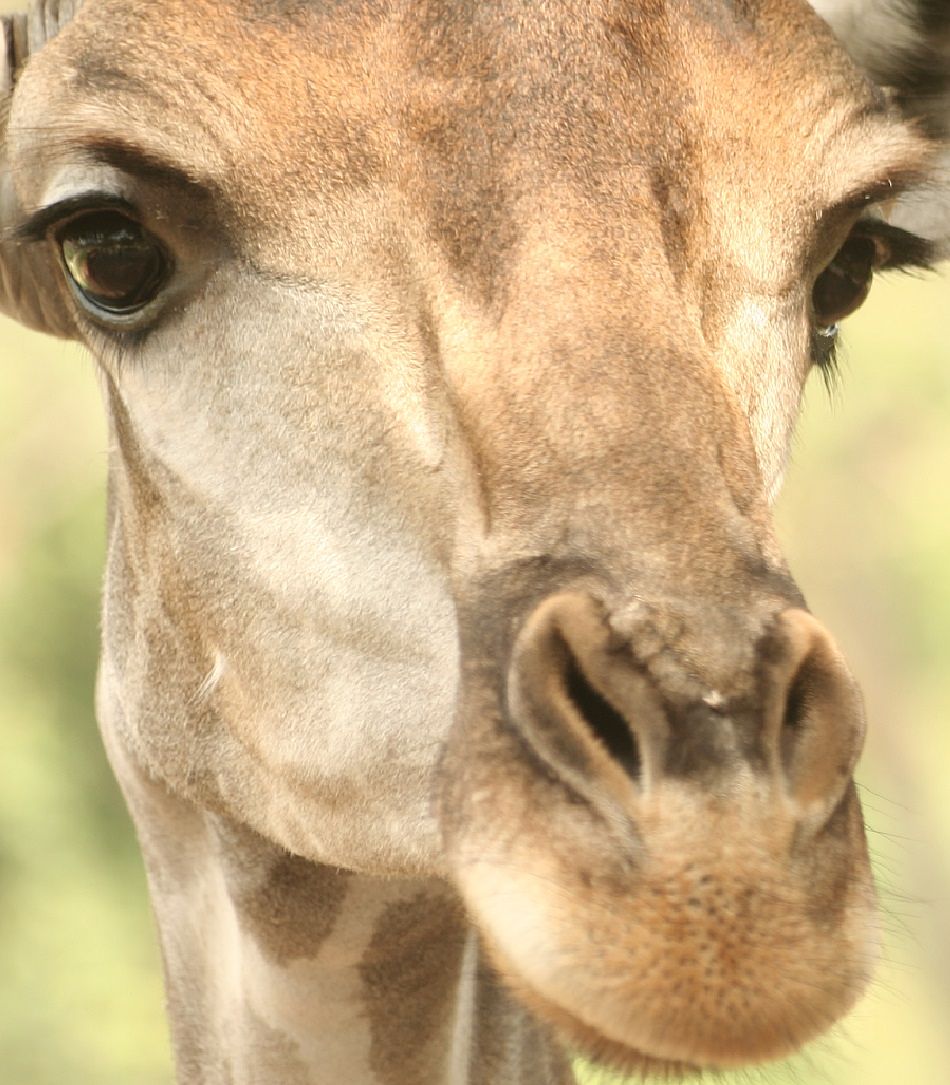Baby giraffe
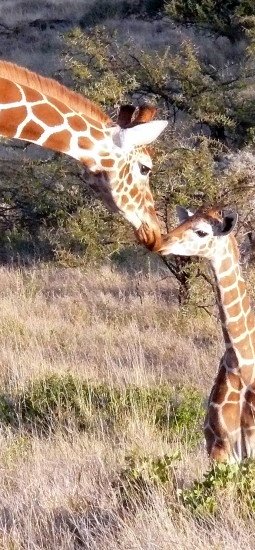 Portrait of a Baby Giraffe
Portrait of a Baby GiraffeA baby giraffe is a sight to behold! Just imagine a "newborn" that is 6 feet tall and weighs 150 pounds!
Giraffe mothers are pregnant for 15 months, giving the embryo time to develop to such a large size, and when ready to come out, the baby comes front feet first, with the neck and head stretched out over the front knees in a sort of "superman" position.
This comes in handy because a mother giraffe gives birth in a standing position, which means the newborn comes into the world falling from a height of over 5 feet.
The fall and the impact break the umbilical cord and the natal sac, and the jolt of landing causes the little giraffe to take it's first breath!
Unharmed by the fall, the infant will take up to an hour to rest where it landed, as the mother licks the infant to stimulate circulation and dry the skin, but Africa's infants must be ready to run with the herd, and remarkably, the newborn giraffe is standing, walking and even running, within about an hour of being born.
Giraffe babies are born with their eyes open, and look very much like miniature adults, but their little horns, called "ossicones" are folded flat against their head while they are inside the mother, and take a few hours to start to stand up straight.
Both males and females have horns known as "occicones", which are formed from cartilage and covered with skin. Females have thinner occicones, that are tufted with longer hair on top. Males occicones are larger, have knobs on the ends, and become bald on top as they mature.
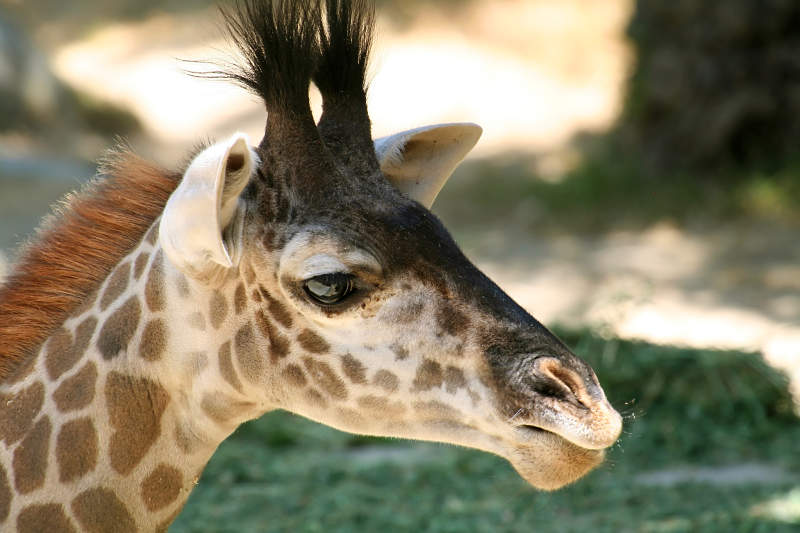 baby giraffe close-up
baby giraffe close-upThe baby also has a shorter neck, percentage wise than an adult, no doubt to fit more neatly in the womb.
The baby giraffe eats only mothers milk for the first four to six months of life, and then begins to sample low growing young shoots and leaves. The leaves of the acacia tree are one of the staples of a giraffes diet. Occasionally, mother giraffes are observed reaching high for a variety of leaves, and bringing them down to their youngster to sample, teaching them what is edible, and where the best feeding is.
Within the first year of life, the young giraffe has doubled in height, with quite a bit of this being added neck length, very necessary as they begin to forage and eat on their own.
Females share in the raising of young with little "day-care" groups of youngsters called creches, that the mothers will take turns supervising.
newborn giraffe
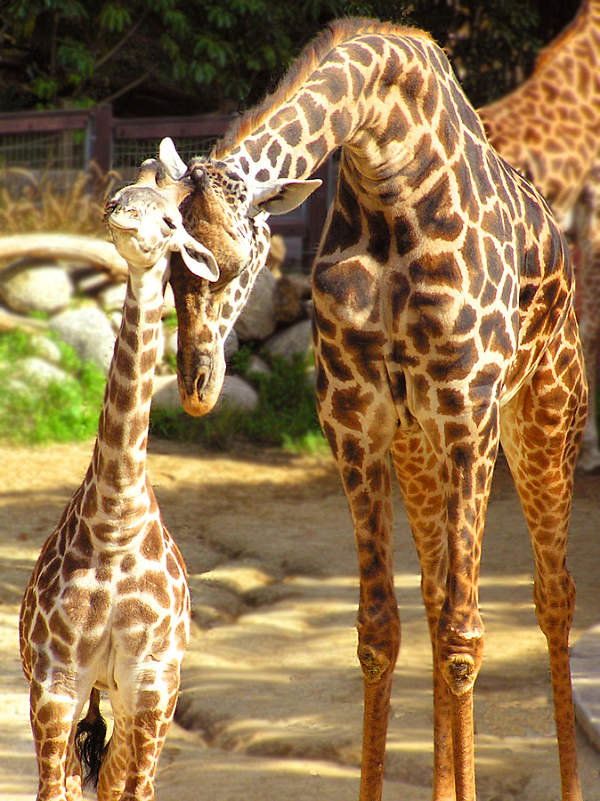
The female is pregnant for about 15 months, and gives birth standing upright.
The newborn hits the ground from a height of 5 or 6 feet, the fall of which breaks the umbilical cord and the natal sac. A newborn baby giraffe stands about 5 or 6 feet at the top of the head, and they can weigh between 140 and up to 200 pounds.
At birth, the occicones are folded back against the head, but spring up in a matter of hours. Baby giraffes often have alot of hair on their occicones, and have amazingly long eyelashes too.
No doubt because of the difficulties of folding up in the womb, the babies neck is not as long, in proportion to the body, as the neck of an adult. Over the first few weeks and months of life, as the baby grows, its neck gets proportionately longer, and at about 4 months old, the youngster is using its long neck to browse for leaves in branches as high as 10 feet.
Giraffes stay with their mothers between 18 months and 2 years, and females in particular, may travel with her from time to time throughout their lives.
Young males may be sexually mature at 6 years old, but will have to wait, usually until they are in their teens, to compete for an opportunity to mate. Males take no part in the rearing of the young, but any groups traveling together will watch for eachother, keep lookout while others drink, and have been known to defend eachother against predators.

giraffe adaptions
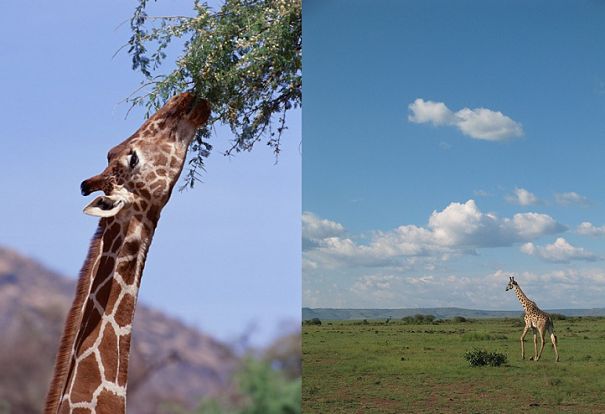 "roaring" baboons
"roaring" baboonsThe standout feature of the giraffe is, of course, that neck! So what kind of special adaptions must occur in order to make such a unique body function properly?
To start with, the giraffe has a 25 pound heart capable of creating the extreme blood pressure required to pump blood 8 feet up to the brain. But when the giraffe lowers its head to eat or drink, the blood rushing down at such high pressure would cause the blood vessels to burst. Pressure sensors along the neck’s arteries monitor the blood pressure and activate contraction of the artery walls (along with other mechanisms) to counter this increase in pressure.
The blood leaving the giraffe’s heart has to do more than just reach the level of the head, it has to be at a high enough pressure to pass through all the fine capillaries that supply the brain and other organs. To achieve this, the blood leaves the heart at a pressure of 200-300 mm Hg which is probably the highest blood pressure of any living animal.
A giraffe’s blood pressure is so high that it would rupture the blood vessels of any other animal, but the arterial walls are much thicker than in other animals, and their skin is so tightly stretched over the body that it acts almost like an anti-gravity suit, keeping the giraffe safely inside the giraffe! - Amazing!

a few more giraffe baby facts
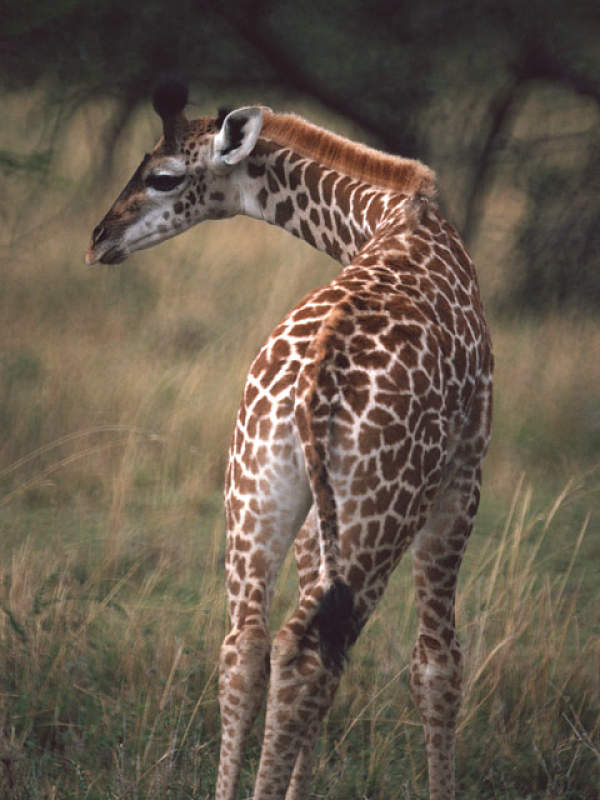
- The giraffe is the largest ruminant and the worlds tallest animal
- Male giraffes can be 18 feet tall at the top of the horns
- Giraffes have 2 to 5 horns called "occicones"
- The giraffes neck is 6 to 8 feet long and can weigh over 600 pounds
- Giraffes "chew their cud" just like cows
- Giraffes defend themselves by kicking
- A giraffes kick can kill a lion!
- The giraffes tongue is about 18 inches long
Scientific Classification:
| Giraffe Facts - animalstats - | |||
|---|---|---|---|
| MALE | FEMALE | YOUNG | SOCIAL UNIT |
| bull | cow | calf | herd |
| HOME | HABITAT | LIFESPAN | FAVORITE FOOD |
| Africa Asia | savanna | 20-25 years | acacai leaves |
| ENEMIES | GENDER DIFFERENCE | AVG. HEIGHT | AVG. WEIGHT |
| lion | males larger | 16-18 feet | 1800-2400 pounds |
| TOP SPEED | GESTATION | BIRTHWEIGHT | BIRTHHEIGHT: |
| 37 mph | 15 months | 150 pounds | 5.5-6 feet |
| RAISED BY | # OF YOUNG | EYES OPEN | STANDS UP |
| mother | 1, rare twins | at birth | 30 mins |
| WEANED | INDEPENDENT | MATURITY | ENDANGERED? |
| 9-12 months | 15-18 months | 4-6 years | some subspecies |
see more animal extreme closeups
Recent Articles
-
African Animals - Animal Facts Encyclopedia
Oct 11, 16 10:27 PM
African Animals facts photos and videos..Africa is a wonderland for animal lovers, and a schoolroom for anyone who wants to learn about nature, beauty and the rhythm of life -
Baboon Facts - Animal Facts Encyclopedia
Oct 11, 16 10:26 PM
Baboon facts, photos, videos and information - Baboons are very distinctive looking monkeys with long, dog-like snouts and close set eyes. -
Great Apes Facts - Animal Facts Encyclopedia
Oct 11, 16 10:25 PM
Great apes facts, photos and videos..Human beings did not evolve from chimpanzees, modern chimps and gorillas do not appear in the fossil records until much more recently than homo sapiens..
